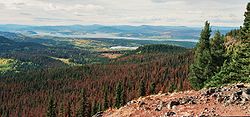Village in British Columbia, Canada
Fraser Lake is a village in northern British Columbia , Canada. It's located on the southwest side of Fraser Lake[ 2] Burns Lake and Vanderhoof alongside the Yellowhead Highway .
The small community's population is primarily employed by either the forest industry. (Fraser Lake Sawmills, or various logging contractors) The Endako Mines, a large molybdenum mine was a former large employer.
The pioneer roots of the area's history date back to the fur trade, with the establishment in 1806 of a fur-trading post by Simon Fraser, at Fort Fraser near the east end of Fraser Lake. The modern day town was established in 1914, during the construction of the Grand Trunk Pacific Railway , and was incorporated as a village in 1966.
Demographics
In the 2021 Census of Population conducted by Statistics Canada , Fraser Lake had a population of 965 living in 444 of its 543 total private dwellings, a change of 2 (1.57 sq mi), it had a population density of 2 (615.6/sq mi) in 2021.[ 3]
Directions
Fraser Lake is supported by nearby communities:
East (Hwy 16):
West (Hwy 16):
North: East Hwy 16, North Hwy 27):
Climate
Fraser Lake is characterized by a continental climate meaning cold, snowy winters and cool to warm summers.
Climate data for Fraser Lake
Month
Jan
Feb
Mar
Apr
May
Jun
Jul
Aug
Sep
Oct
Nov
Dec
Year
Record high °C (°F)
11.0
11.0
17.0
23.9
32.5
32.5
34.0
35.0
32.0
23.0
16.5
12.0
35.0
Mean daily maximum °C (°F)
−5.2
−1.1
4.2
10.5
16.1
19.7
22.2
21.9
16.8
9.4
0.8
−4.0
9.3
Daily mean °C (°F)
−9.5
−6.4
−1.6
4.1
9.4
13.1
15.4
14.9
10.4
4.7
−2.5
−7.9
3.7
Mean daily minimum °C (°F)
−13.8
−11.7
−7.4
−2.3
2.6
6.5
8.5
7.9
4.1
−0.1
−5.7
−11.6
−1.9
Record low °C (°F)
−46.1
−42.0
−38.9
−20.5
−7.2
−3.0
−1.5
−2.5
−7.0
−24.0
−39.0
−47.5
−47.5
Average precipitation mm (inches)
47.9
29.5
25.7
23.1
42.0
57.0
57.4
46.5
47.9
54.8
48.8
45.2
525.8
Average rainfall mm (inches)
5.4
4.3
5.4
16.6
40.9
57.0
57.4
46.5
47.9
46.2
19.3
3.9
350.7
Average snowfall cm (inches)
42.5
25.2
20.3
6.5
1.1
0.0
0.0
0.0
0.0
8.7
29.5
41.3
175.1
Average precipitation days (≥ 0.2 mm)
12.4
9.1
9.2
8.5
12.5
14.0
13.0
12.2
12.5
15.2
14.1
11.5
144.1
Average rainy days (≥ 0.2 mm)
2.1
2.3
3.4
6.5
12.1
14.0
13.0
12.2
12.5
14.0
6.7
1.7
100.5
Average snowy days (≥ 0.2 cm)
11.1
7.2
6.6
2.7
0.5
0.0
0.0
0.0
0.0
2.3
9.1
10.6
50.2
Source: [ 4]
Notable people
References
^ "British Columbia Regional Districts, Municipalities, Corporate Name, Date of Incorporation and Postal Address" (XLS ). British Columbia Ministry of Communities, Sport and Cultural Development. Archived from the original on July 13, 2014. Retrieved November 2, 2014 .^ "Fraser Lake (village)" . BC Geographical Names ^ "Population and dwelling counts: Canada, provinces and territories, and census subdivisions (municipalities), British Columbia" . Statistics Canada . February 9, 2022. Retrieved February 20, 2022 .^ "Calculation Information for 1981 to 2010 Canadian Normals Data" . Environment Canada. Archived from the original on February 10, 2014. Retrieved July 9, 2013 .
External links

